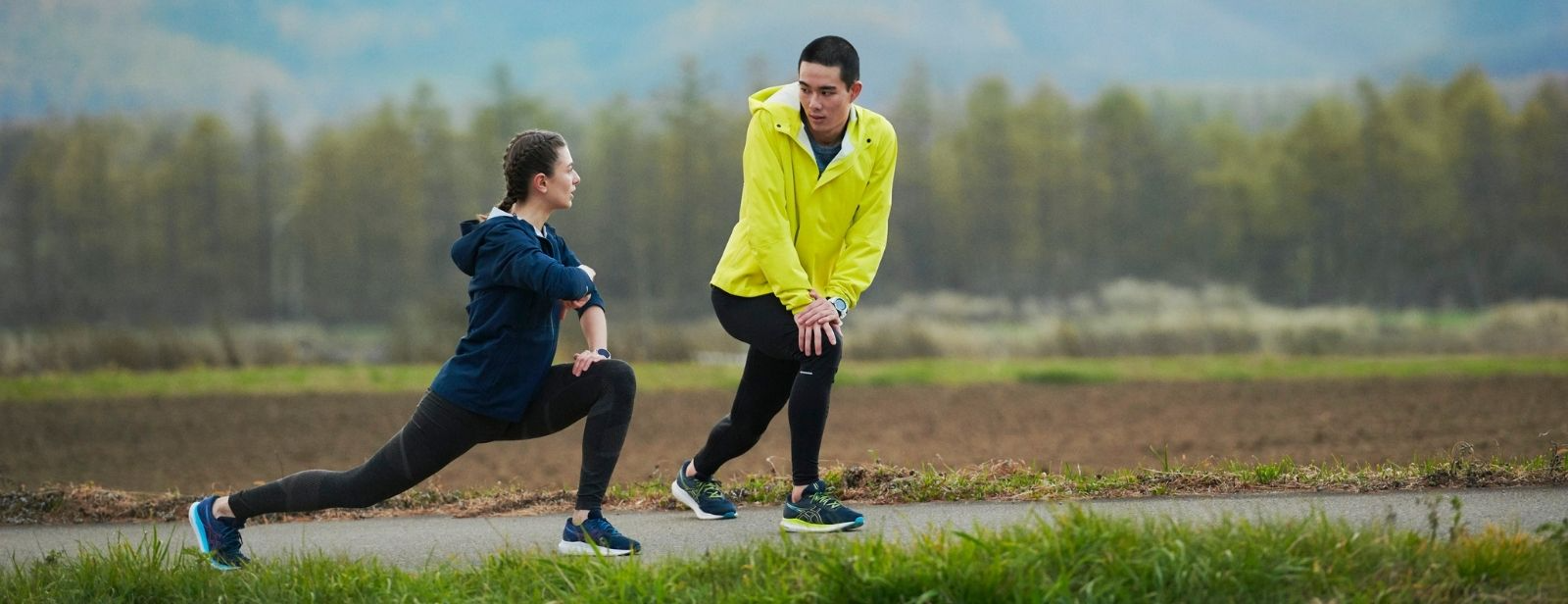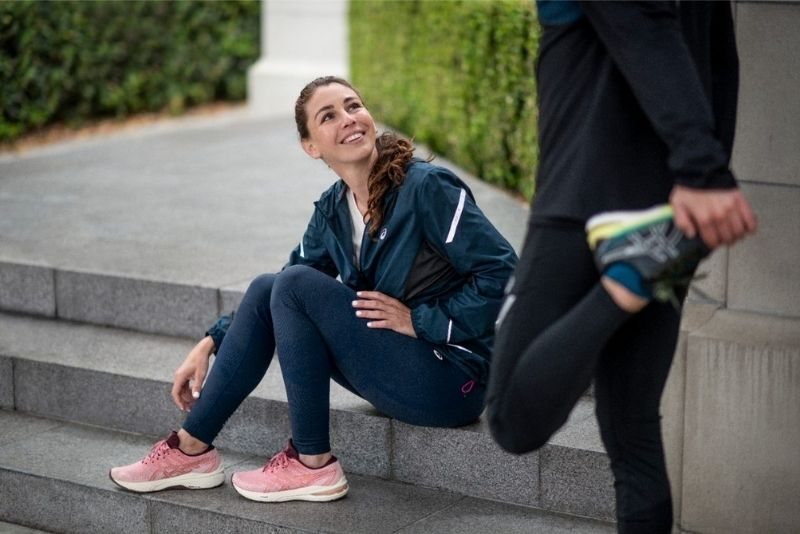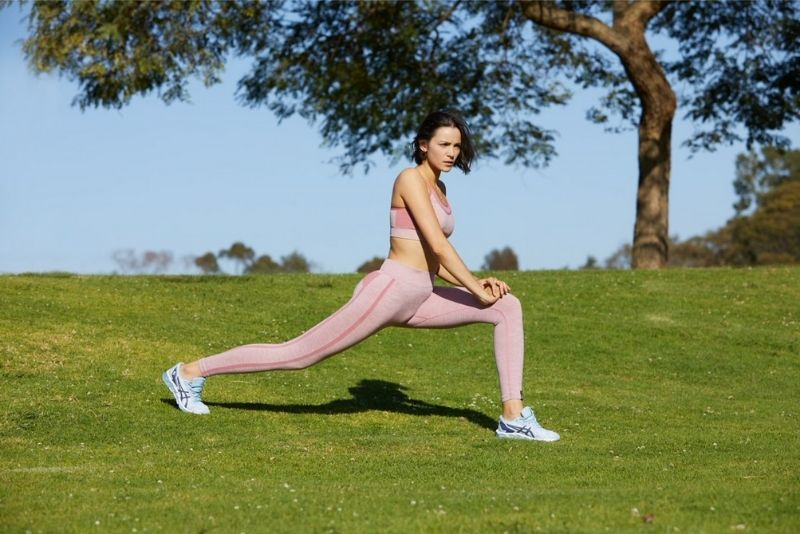
Stretches for Runners
December 9, 2021
Running stretches are an essential part of your daily training program. Not only do running stretches maintain the health and longevity of your muscles, they help to prevent injuries and can improve your running performance.
You should stretch before running and after running with a proper warm-up and cooldown.
Let’s take a look at how to stretch for runners and why it is important for Sound Mind, Sound Body.
Why is stretching important for runners?
When you exercise, your muscles shorten and tighten up. Over time, stiff muscles become weak and more resistant to exercise. They lose their flexibility and as a result, your joints suffer and your risk of injury goes up. Stretching after running helps to relieve stiff muscles and keeps them flexible, strong and healthy.
Stretching before and after running warms and elongates your muscles, increasing the range of motion in your body for safe and comfortable exercise. It also helps to sharpen your mental focus. This can strengthen your body-mind connection and improve your overall running performance. That is why pre-run stretches and post-run stretches for runners are so important.
Timing is one of the most important factors in how to stretch for running. To get the most out of your running stretches, let’s take a look at some ideal times to stretch.
When should runners stretch?
For post-run stretches, it’s important to make sure your body is sufficiently cooled down and your heart rate has returned to a comfortable rate before you begin.
For pre-run stretches, you want to increase your heart rate so the blood flows into your muscles. You’ll get the most out of your stretches if you time it right.
Let’s take a look at some ideal times for runners to stretch.
- After easy runs. When your muscles are warm but not overstressed, focus on stretching your large muscle groups such as your hamstrings and quads. You can use both static and dynamic stretching to help your muscles relax.
- After hilly runs. Focus on stretching those muscles most involved on both descents (hamstrings) and ascents (calves and quadriceps).
- Mornings and evenings. Light, simple stretches first thing in the morning can help work out the stiffness in your muscles and tendons. Gentle, relaxed stretches before bed at night can help increase your range of motion and improve your sleep.
- After a bath or shower. When your muscles are already warmed up, take advantage of this time to work on your flexibility.
- Before your run. To prepare your muscles and get the blood flowing, try some dynamic stretches. You’ll find your running performance improves when you do.
Pre-run stretches
Before you hit the road or the trails, take the time to warm up your body. It only takes a few minutes and it will help build your muscle resilience, which may help avoid an injury. Here are some recommended stretches for runners.

1. Walking lunges
From a standing position, place your hands on your hips, walk one leg forward into a lunge and bend both your knees at 90 degree angles, in line with your ankles. Return to standing with your feet together and repeat on your other leg. Perform 12-15 strides per leg. This is a great warm-up for your hips and glutes, and helps to activate your core.
2. Hamstring sweep
Take a small step forward, bend your back knee while bowing forward and sweeping your arms up in front of you. Return to standing and step forward with the other leg, gradually moving forward as you do. Repeat 12-15 times each leg. Not only does this running stretch warm up your hamstrings and activate your core muscles, it’s also a good stretch for the calf muscles.
3. Hip circles
From a standing position, raise one knee up to your chest and take it out to the side. Return to standing and repeat on your other knee, 12-15 each leg. This running stretch helps to warm up your hip flexors and groin muscles, and strengthens your joints.
4. High knees
Alternating your legs, bring one knee up to your chest and hold, before switching to your other knee. You can add walking to this exercise by stepping forward after each knee-up. Repeat 12-15 times each leg. A great warm-up for your gluteal muscles.
5. Jumping jacks
Standing with feet together and arms at your sides, jump your legs out to the side while swinging your arms out and up to meet above your head. Keep the movement smooth and fluid. Perform 15 jumping jacks and repeat for 3 sets. Jumping jacks are a great finisher to your pre-run stretches to get your heart pumping.
Post-run stretches
Post-run stretches strengthen your flexibility and joint mobility, leading to long, lean, healthy muscles. It is the ideal time to stretch your muscles.

6. Hip flexor stretch
Begin in a lunge position with hands on your thigh and your torso tall and slightly forward. Drop your back knee down to the ground and hold for a maximum of 30 seconds. Repeat on the other leg, 2-3 times on each leg. This stretch opens up your hip area and relieves tension in your flexors.
7. Downward facing dog
Starting on all fours, straighten your legs and try to get your heels to the ground, while you push back with straight arms. Keep your wrists in line with your shoulders and your elbows close to your ears. Hold for 3 deep breaths and relax into Child’s Pose. Repeat 3-6 times. Downward dog is a great running stretch for your back, all the way down to your hamstrings, calves and ankles.
8. Hamstring stretch
Standing tall, bring your leg up to rest on a bar or chair. Bend at the waist and reach forward with your arms. Hold for 30 seconds and repeat 2-3 times on each leg. Hamstring stretches improve flexibility and your range of motion in the hip joint.
9. Calf stretch
Stand facing a wall and bring one leg forward to a 90-degree angle with the knee. Straighten your back leg and rest your hands on the wall for support. Concentrate on flattening your back heel. Hold 30 seconds and repeat 2-3 times each side. Not only does this running stretch work the muscles in your lower leg, it’s a great stretch for your Achilles tendon.
10. Iliotibial (IT) band stretch
Standing sideways to a wall, cross one leg in front of the other. Using the wall as support, place your outer hand on your hip and raise your other arm over your head, bending at the waist. Hold for 30 seconds and repeat 2-3 times each side. This stretch focuses on your outer thigh, while relieving stiffness in your spine, torso and hips.
Stretching tips for runners
The number one tip for runners is to stretch every day. Stretching keeps your body supple, conditioning your muscles and joints. Here are a few tips to help you get the most out of your running stretches:
Tips for stretching before running
The whole purpose of doing running stretches before running is to lubricate your muscles and joints by increasing your blood circulation. From your muscles to the brain, stretching before running helps to prepare yourself mentally as well as physically.
Here are a few tips on running stretches to get your started:
- Never stretch a cold muscle – you need to get your blood flowing first
- Hold stretches for 30 seconds – but no more than 30 seconds as this is the optimum time needed for the most benefit
- Don’t hurt yourself – stretching should loosen up your muscles, not be painful
- Stay still when you stretch – bouncing or hopping can cause injury
- Stretch after a shower if your muscles are tight – the hot water warms your muscles and helps to loosen you up before a run
Tips for stretching after a run
After exercise, your muscles will shorten and tighten up. Running stretches elongate your muscles, increasing flexibility and improving range of motion in your joints. Here are a few tips to know before you begin:
- Avoid forcing your stretches. Listen to your body and only stretch as far as you are comfortable. Overstretching can do more harm than good.
- Breathe properly. Coordinate your breathing with your stretching movements to help relax your body and increase your reach.
- Cool down before you stretch. To avoid lightheadedness, give your heart and blood pressure a chance to return to normal before stretching.
To get the most out of your stretching for running performance, do them before and after training. Stretching has a cumulative effect and is something you need to work on every day. The more you stretch, the greater your flexibility and the better your mobility. Complete your running experience with ASICS full collection of running shoes and apparel:
* Before undertaking any physical activity or stretching, seek the advice of your healthcare provider.